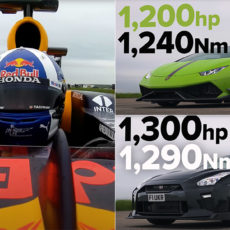
In 1991, at the Tokyo Motor Show, Isuzu unveiled a concept so audacious it could make a monster truck blush. This wasn’t just another utilitarian pickup destined for construction sites or rural backroads. It was the Como F1 Super Truck, a vehicle that married the gritty practicality of a ute with the screaming heart of a Formula 1 race car. Yes, you read that right: a pickup truck powered by an F1 engine.
Japan in the late 1980s and early 1990s was a playground for bold ideas. Flush with cash from a booming economy, carmakers like Isuzu were eager to flex their creative muscles. Known for rugged trucks and dependable SUVs, Isuzu wasn’t exactly a household name in motorsport. But a group of its engineers, perhaps sipping too much coffee or dreaming of racetrack glory, decided to build a 3.5-liter V12 engine—codenamed P799WE—for Formula 1.
- COLLECTIBLE F1 RACE CAR – Celebrate historic F1 innovation with this LEGO Icons Williams Racing FW14B & Nigel Mansell building set for adults and...
- MODEL BUILDING SET – Everything you need to build a LEGO F1 Williams Racing FW14B race car and Nigel Mansell minifigure, plus a display stand,...
- REALISTIC FEATURES & FUNCTIONS – This LEGO Icons Williams Racing FW14B F1 race car model features working steering, wide rear slick tires with...

This wasn’t a typical truck motor; it was a high-revving, 740-horsepower beast designed to compete with the likes of Ferrari and McLaren. When their F1 dreams fizzled, thanks to a collapsing economy and a failed partnership with Team Lotus, Isuzu faced a dilemma: what to do with this monstrous engine? Their answer? Stick it in a pickup truck.

Enter Simon Cox, a designer with a knack for the unconventional. Cox, who later penned the equally bonkers Cadillac Cien, crafted a vehicle that looked like it had rolled out of a sci-fi flick. The Como F1 Super Truck was sleek, low-slung, and curvaceous, with a “blobject” aesthetic that screamed 1990s futurism.

Forget the boxy pickups of the era—this thing had scissor doors, the kind you’d expect on a Lamborghini, not a vehicle with a cargo bed. Measuring 4600 mm long, 1830 mm wide, and just 1370 mm tall, it was more supercar than truck, with a wheelbase of 2950 mm for stability. The four-seat cabin added a surprising dose of practicality, as if Isuzu thought you might take this F1-powered beast on a family road trip with a few bags in the back.

That V12 engine, mounted in the middle of the chassis, was the star of the show. Producing 740 horsepower at a screaming 13,500 RPM and 418 Nm of torque at 11,500 RPM, it outmuscled even the legendary McLaren F1’s naturally aspirated V12.
Exact performance figures are scarce—Isuzu never released official top-speed or 0-60 mph times—but estimates suggest it could hit 200 mph. To put that in perspective, most pickups of the era struggled to break 100 mph. The Como’s rear-wheel-drive setup and aerodynamic shape, honed in wind tunnels, made it a theoretical rocket on wheels. Yet, it still had a “decent-sized” cargo bed, because why not haul some lumber while you’re outrunning supercars?










